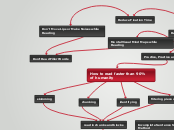gathering...
Receptive Skills and Challenges in Language Learning:
1. Introduction
Definition of Receptive Skills: Reading, listening, and, more recently, viewing images and audiovisual texts.
Goals: Understanding written and spoken texts, decoding images, connecting text and images (e.g., comics, films, digital texts).
Relevance: Modern information and communication technologies place new demands on language learning.
2. Interactive Processes
Top-Down Processing: Interpretation based on prior knowledge, expectations, and context (schema, genre knowledge).
Examples of Activities: Generating questions, making predictions, activating background knowledge.
Bottom-Up Processing: Constructing meaning through decoding of words, grammar, and symbols.
Examples of Activities: Recognizing details, starting with the text as the main source of information.
3. Challenges
Deficits in Receptive Skills: Lack of top-down processing among less successful learners.
Errors in Classroom Practice:
Focus on word-by-word comprehension instead of general text understanding.
Combining listening and reading at the same time, which can cause confusion.
Difficulties in Listening Comprehension: Speed and variations in language can pose challenges.
Films: Multimodal demands (language, visual cues, film-specific techniques).
4. Teaching Approaches
Process-Oriented Approach:
Pre-Phase: Preparatory activities, such as generating expectations and activating background knowledge.
While-Phase: Structure and tasks to support understanding.
Post-Phase: Reflection, personal reactions, and deeper engagement with the text.
Techniques:
Reading Techniques: Skimming, scanning, intensive reading, making inferences, contextual guessing.
Listening Techniques: Global listening, listening for specific information, inference.
5. The Role of Emotions
Emotions: Help with memory retention, capture attention, and link content to personal experiences.
Support in Teaching: Considering emotions to promote deeper comprehension.
6. Interdependence of Genre, Goal, and Strategy
Genres and Goals: Using different types of texts and media for everyday situations (brochures, films, news).
Purposes for Reading and Listening in Real Life:
Reading Purposes: Gathering information, following instructions, enjoyment.
Listening Purposes: Public announcements, media, conversations.
These points provide a strong foundation for your mindmap and cover the main topics from the text.
Interdependence of Genre, Goal, and Strategy
Purposes for Reading and Listening in Real Life
Listening purposes
conversations
media
(public) announcements
Reading purposes
enjoyment
instructions
information
Genres and Goals in language learning: Using different types of texts and media for everyday situations (brochures, films, news).
The Role of Emotions
Support in Teaching: Emotions in promoting deeper comprehension
Emotions: Help with memory retention, capture attention, and link content to personal experiences.
4) Teaching Approaches
Techniques for Listening
Global listening
inference
specific information
Techniques for Reading
Making inferences and contextual guessing
Skimming
intensive reading
scanning
Process-Oriented Approach
Post-Phase: Reflection, personal reactions, and deeper engagement with the text.
While-Phase: structure and tasks to support understanding.
Pre-Phase activities: such as generating expectations and activating background knowledge.
3) Challenges
Difficulties in Listening Comprehension
Multimodal demands in films (language, visual cues, film-specific techniques).
Speed and variations in language
Errors in Classroom Practice
Combining listening and reading simultaneously, can cause confusion
Focus on word-by-word comprehension
Deficits in Receptive Skills
Lack of top-down processing among less successful learners
2) Interactive Processes
Bottom-Up Processing
Examples of Activities: Recognizing details, starting with the text as the main source of information.
Definition: Constructing meaning through decoding of words, grammar, and symbols.
Top-Down Processing
Examples of Activities: Generating questions, making predictions, activating background knowledge.
Definiton: Interpretation based on prior knowledge, expextations and context (schema, genre,..)
1) Introduction
Relevance of Receptive Skills in Modern Communication (place new demands on lannguage learning - 1990)
Goals: Understanding written and spoken texts, decoding images, connecting text and images (e.g., comics, films, digital texts).
Definition of Receptive Skills: Reading, listening, and, more recently, viewing images and audiovisual texts.









